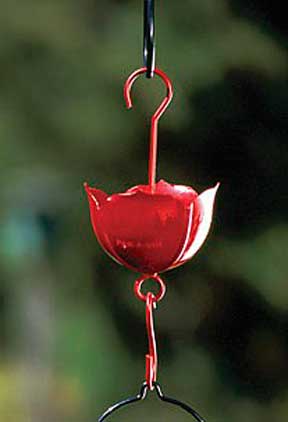-
How Does Super Squirrel Get Past the Squirrel Baffle?
There must be a group of hybrid grey squirrels in the yard. Super athletes who jump higher and stretch farther. For the longest time it seems there’s been no hanky-panky going on with the front bird feeder, but lately it’s really been out of hand! The shepherd’s hook, complete with squirrel baffle has been successful at keeping squirrels from the feeder…until now.
After finding the feeder broken on the ground one morning, I salvaged the bottom bowl and crafted a new weather guard by bending an old metal one to fit the space between pole and arm of the stand . Tightening the hardware, and moving the squirrel baffle upwards, surely would fix this problem? Nope. The next day while sitting outside, the sound of clanking metal started grating on my nerves. Time to revisit the feeder!
Removing the weather guard, I placed the feeder at the very top of the hook’s arm. Using 2 small bungee cords to secure the hanger worked great until the rainy season started in Georgia. Back to the drawing board. Now returning the bent weather guard, I raised the feeder, which only allowed a small space for birds’ entry. The squirrel baffle was again moved up as far as it would go, touching the bottom of the feeder. So far, so good! It looks a little strange, but the birds don’t seem to mind. The squirrels around here must have gotten hold of steroids or something because their ability to get into feeders has been absolutely uncanny!
-
The Difference Between Ant Moats and Ant Baffles
To protect your hummingbird-or any nectar feeder from ant hassles, the use of ant moats is strongly recommended. For the newer staked versions of hummingbird feeders, the ant baffle was invented. Essentially, it’s an upside down ant moat.
Instead of holding water to prevent ants’ crossing, the baffle requires a coat of petroleum jelly on the underside. This works the same way as far as preventing the ants from getting to nectar.
If you’ve ever encountered problems with ants at nectar feeders…well, once is enough! Ant moats like these by Parasol, are a one-time, relatively inexpensive solution to this nasty problem.
For those who enjoy watching the “flying jewels” feed close up, check out this great video produced by Parasol.
-
The Invaluable Ant Moat
Ants just love sugary, sticky, sweet nectar! Whether it’s Hummingbird, Oriole or butterfly nectar, if they can get to it…you bet they will find it! But the good thing, and saving grace for those who feed nectar, is that ants can’t swim. They are virtually unable to cross a small body of water. Enter the invaluable ant moat.
These little gadgets make the difference between great birding experiences vs. pesky, miserable ones filled with unwelcome guests. Simple by adding an ant moat to your hummingbird feeder, or other nectar feeders, you will stop ants dead in their tracks.
The ant moat shown here is a little nicer than the standard model, but they all do the same thing…stop ants from getting at nectar. In the heat of summer, a drop of salad oil may be added to the water to slow the evaporation process. Remember, the ant moats will not work unless they are kept filled with water.




